Malcolm R. Campbell's Blog, page 237
August 24, 2011
'Sarabande' GiveAway on GoodReads

Three free copies of my new fantasy "Sarabande" are available on GoodReads in a giveaway celebrating the pending release of the paperback edition. To enter, just click on the widget in the right-hand column of this blog.
The novel is already available in an e-book format on Kindle and Smashwords as well as on Kindlegraph.
New Blog for Writers
I have started a WordPress blog called Malcolm's Book Bits and Notions. I come across so many reviews, news and feature stories, and other bits and pieces of book information every week, I decided to put the links into posts so others can pick and choose.
Hope you find some helpful links there.
--Malcolm
Published on August 24, 2011 07:46
August 19, 2011
People tend to Google everything - so why write a book review in the dark?
Going on a date with somebody? Google him or Google her and see what they've been up to. That's part of today's dating ritual.
See a bit of history on a TV show and think it's wrong? Google it. If you're wrong, nobody's going to know. If you're right, you can tell your friends, make an enlightened comment on Facebook, or leave a comment on the program's blog or website.
In this Google world, I was surprised to read an online book review today about a well known, award winning book set in another country in another era and find that the reviewer didn't understand some of the political terms in the novel. The reviewer enjoyed the book, but was a bit puzzled by the politics.
This seems to be a common reader complaint: being puzzled by a book due to lack of knowledge that's really easy to look up. Quite often, the author will fill in some of the details about political parties, movements, geographical areas, cities and their histories, etc. as it applies to the plot and to the characters' motivations.
If not, why not Google the name of the political party, town, forest, mountain range or famous person out of the past? You'll know the answer in an instarnt and the novel will make more sense--especially if you plan to review the book.
Now, I don't expect people who are searching for random facts in novels to be a major online force when Yahoo and other search engines track what's trending at the moment. But really, typing "Rabat" or "Tory" or "Virginia Woolf" into search field doesn't take any longer than typing "Burger King Ads," "Hershey Walkout" or "Daniel Radcliffe."
That's my two cents for this Friday afternoon.
--Malcolm
See a bit of history on a TV show and think it's wrong? Google it. If you're wrong, nobody's going to know. If you're right, you can tell your friends, make an enlightened comment on Facebook, or leave a comment on the program's blog or website.
In this Google world, I was surprised to read an online book review today about a well known, award winning book set in another country in another era and find that the reviewer didn't understand some of the political terms in the novel. The reviewer enjoyed the book, but was a bit puzzled by the politics.
This seems to be a common reader complaint: being puzzled by a book due to lack of knowledge that's really easy to look up. Quite often, the author will fill in some of the details about political parties, movements, geographical areas, cities and their histories, etc. as it applies to the plot and to the characters' motivations.
If not, why not Google the name of the political party, town, forest, mountain range or famous person out of the past? You'll know the answer in an instarnt and the novel will make more sense--especially if you plan to review the book.
Now, I don't expect people who are searching for random facts in novels to be a major online force when Yahoo and other search engines track what's trending at the moment. But really, typing "Rabat" or "Tory" or "Virginia Woolf" into search field doesn't take any longer than typing "Burger King Ads," "Hershey Walkout" or "Daniel Radcliffe."
That's my two cents for this Friday afternoon.
--Malcolm
Published on August 19, 2011 12:36
August 13, 2011
Fantasy often begins with an old myth or legend

"We call it Lightning Falls," said Marten. "Deucalion named it so. A holy man appeared to him in a dream and said, 'Stand inside the storm and you will find nothing but the freedom of your dreams.' The sky was black at noon, so the story goes, when lightning struck the rock, creating a tunnel. A thousand people walked through before time closed the portal and guarded it with a pillar of fire." -- from "The Sun Singer"
Alice steps into a fantasy world via a rabbit hole. Lucy finds Narnia via a wardrobe in a professor's house. Harry Potter walks through a hidden passageway at a London train station. In my 2004 novel The Sun Singer, Robert Adams finds Pyrrha via a remote mountain cabin.
Hidden worlds in fantasy novels are frequently reached via portals or tunnels, and they open up before the reader and the protagonist as realities complete with customs, characters, background myths and legends. My alternative world is called Pyrrha, named after the wife of Deucalion from the Greek myth of the flood. (The graphic here shows Deucalion and his Pyrrha in the version of the story told my Ovid.)
North American Connection
In The Sun Singer, the residents of Pyrrha believe that Deucalion and Pyrrha came to North America as they fulfilled their orders from Zeus to repopulate the world. To avoid conflict, they left the reality that would ultimately become Glacier National Park and followed a tunnel into a look-alike world they named Pyrrha.
Greece, Zeus, Deucalion and Pyrrha have nothing to do with the plot of The Sun Singer. I included them in the book to give the world of Pyrrha a solid foundation. Likewise, readers of Alice's Adventures in Wonderland, The Chronicles of Narnia, and Harry Potter and the Sorcerer's Stone also find secret worlds that not only exist in the here and now, but also have a history to them. Tolkien, of course, went further than anyone in creating a living and breathing world in Lord of the Rings.
Sarabande Leaves Pyrrha and Returns
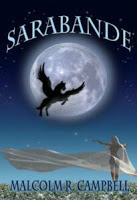
Fantasy, like its cousin magical realism, needs an anchor to keep it from becoming wholly speculative and ephemeral. I grew up with the Athurian legends, Middle Earth, and Narnia, and was always impressed by the fact that the masters of fantasy gave readers a lot more than a thinly constructed arena for the here-and-now adventures of their stories. They created worlds with as much depth as our own.
Like The Sun Singer, my upcoming fantasy adventure novel Sarabande gets its depth from the myths and legends behind the world or Pyrrha as well as the very real mountain world of Glacier National Park. My intention here is to give the reader the impression that my protagonist Sarabande's journey begins and ends at a place so real, her story quite possibly is true.
In The Sun Singer, young Robert Adams finds adventure by leaving his home in Illinois, traveling to Glacier Park and discovering Pyrrha. In Sarabande, the young Sarabande finds adventure by leaving and then returning to Pyrrha. That is, her trials and tribulations occur on both sides of the magic doorway between worlds.
Readers already believe in the stuff of which their own world is made. If I can lure them into believing in the stuff of my fantasy world, then I have a strong foundation for telling them a good story. Background myths and legends are an old writing technique that can be a writer's best friends.
--Malcolm
Published on August 13, 2011 07:38
August 3, 2011
If only we stayed as curious as children
Just watching my granddaughter puzzle out how things work makes me smile.
With toys, computers, or her mother's digital camera, she wants to know all the variations the object is capable of performing. And then she experiments. What does the world look like when the camera is upside down, closer, farther way. Which toys float and which do not? How does one peel an orange or open up a small, individual pack of Gouda cheese? The red covering of the cheese fits on one's nose, one's ear, on the end of a crayon, did you know?
Writers, I think maintain some of this curiosity. So, too, with artists, actors, musicians--how many ways can one improvise on what is or what might be?
There's unconcerned innocence in my granddaughter's improvisation, for while she knows that certain actions make things break, she isn't to the point of anticipating what untried actions might also be dangerous in some way.
Unfortunately, we give up some of our innocent play when we ldearn to think ahead and consider the consequences of one thing vs. another thing. A necessary step, I suppose, but we give up so much when we finally take it.
How dull life can seem without the what if of a writer, a painter or a child. I like watching my granddaughter's what if play because it reminds me of how I was--and of how I can be for short periods of time when I write.
With toys, computers, or her mother's digital camera, she wants to know all the variations the object is capable of performing. And then she experiments. What does the world look like when the camera is upside down, closer, farther way. Which toys float and which do not? How does one peel an orange or open up a small, individual pack of Gouda cheese? The red covering of the cheese fits on one's nose, one's ear, on the end of a crayon, did you know?
Writers, I think maintain some of this curiosity. So, too, with artists, actors, musicians--how many ways can one improvise on what is or what might be?
There's unconcerned innocence in my granddaughter's improvisation, for while she knows that certain actions make things break, she isn't to the point of anticipating what untried actions might also be dangerous in some way.
Unfortunately, we give up some of our innocent play when we ldearn to think ahead and consider the consequences of one thing vs. another thing. A necessary step, I suppose, but we give up so much when we finally take it.
How dull life can seem without the what if of a writer, a painter or a child. I like watching my granddaughter's what if play because it reminds me of how I was--and of how I can be for short periods of time when I write.
Published on August 03, 2011 11:31
July 30, 2011
Writers Open Windows to Unknown Worlds
"How is it that a work of art, bearing the mark of the artist's deep unconscious resources, can act on other people, on someone other than the artist himself? It is because the archetypes which flood the unconscious of all of us are part of a much larger collective unconscious. The work of art, being thus charged with the unconscious material we share with the artist, is able to arouse resonances within us." -- Jean E. Charon in "Man in Search of Himself"
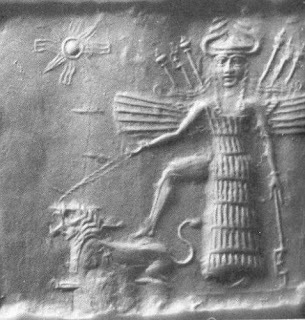
I read Man in Search of Himself about the same time I read Joseph Campbell's The Hero with a Thousand Faces and they became a mantra. Using art to include fiction and poetry, it was clear to me just why the hero's journey had such a profound influence on so many novels and feature films. Over and above the action in the storylines, the myths that formed the basis of the work resonated with readers and viewers in profound ways.
The writer (publisher, producers, actors) seldom meet any of the readers and viewers who are drawn to their work. So, they seldom have a chance to compare notes about what they found in the work.
Whether it's a movie or a novel, the story--and advertisements and word of mouth promoting that story--is usually what draws people to a film or novel. Once there, the resonances that occur when writers and directors open windows to unseen worlds may not be imediately conscious. Quite often, readers and viewers will say a book or movie is a favorite, perhaps that they have gone back to it again and again, yet they will struggle trying to find the words to explain why.
The reason is often that some aspect of the myth--the mythos--behind the plot has struck a deep and emerging need within the reader or viewer that s/he has not yet discovered. In fact, as Marianne Burke writes in her book Re-Imagining Mary, artists who have provided sacred "scenes have provided us with 'windows' into depths unknown perhaps even to them."
The resonances, windows, depths, and myths may be unknown when the works are produced, only to be discovered later as artists, authors, producers, critics, readers and reviewers begin discussing just what it was that drew them into the story and, once there, what they found.
Carl Jung wrote in his Red Book that "To give birth to the ancient in a new time is creation." This birth happens because the writer/artist has conciously or subconsciously been drawn to an archetype and/or an old need within himself or herself to explore something that his/her life requires. So, s/he opens a window into a world that's been personally unknown within his or her experience.
Once that window is open, whatever is "out there" becomes part of the artist and--if it produces a strong impact--his or her paintings, screenplays and novels as well. While working on my novel Sarabande (due out this fall), I was drawn to the myth of Inanna's Descent to the Underworld. The story dates back thousands of years. Why did it resonate with me like one tuning fork next to another tuning fork?
Why the resonances now?
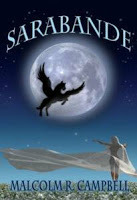
Perhaps the old story resonated with me now because it works so well as part of a heroine's journey novel. When you read Sarabande, you'll find the Inanna myth within it, and it will either resonate with you or it will pass you by as just another wrinkle in the plot. "Myths or mythos," writes Marianne Burke, "express truth closer to life's meaning than facts."
Such truths may be truths I have needed to deal with. That is, the Inanna myth may well have come forward now because it expressed truths my life was ready to accept. I tend to think this is the case rather than seeing the trials of an ancient Sumerian goddess as an interesting theme only within my novel.
Usually, rushing to answer such a question obliterates the question. It's rather like trying too hard to capture a dream that was so clear just moments before waking up. So, I tend to let the matter sit, simmering on the back burner, until the reasons it's important to me become clear. It's like that with readers and film viewers as well, I think. They come away from films and novels with truths and experiences that won't become evident for years to come.
--Malcolm

I read Man in Search of Himself about the same time I read Joseph Campbell's The Hero with a Thousand Faces and they became a mantra. Using art to include fiction and poetry, it was clear to me just why the hero's journey had such a profound influence on so many novels and feature films. Over and above the action in the storylines, the myths that formed the basis of the work resonated with readers and viewers in profound ways.
The writer (publisher, producers, actors) seldom meet any of the readers and viewers who are drawn to their work. So, they seldom have a chance to compare notes about what they found in the work.
Whether it's a movie or a novel, the story--and advertisements and word of mouth promoting that story--is usually what draws people to a film or novel. Once there, the resonances that occur when writers and directors open windows to unseen worlds may not be imediately conscious. Quite often, readers and viewers will say a book or movie is a favorite, perhaps that they have gone back to it again and again, yet they will struggle trying to find the words to explain why.
The reason is often that some aspect of the myth--the mythos--behind the plot has struck a deep and emerging need within the reader or viewer that s/he has not yet discovered. In fact, as Marianne Burke writes in her book Re-Imagining Mary, artists who have provided sacred "scenes have provided us with 'windows' into depths unknown perhaps even to them."
The resonances, windows, depths, and myths may be unknown when the works are produced, only to be discovered later as artists, authors, producers, critics, readers and reviewers begin discussing just what it was that drew them into the story and, once there, what they found.
Carl Jung wrote in his Red Book that "To give birth to the ancient in a new time is creation." This birth happens because the writer/artist has conciously or subconsciously been drawn to an archetype and/or an old need within himself or herself to explore something that his/her life requires. So, s/he opens a window into a world that's been personally unknown within his or her experience.
Once that window is open, whatever is "out there" becomes part of the artist and--if it produces a strong impact--his or her paintings, screenplays and novels as well. While working on my novel Sarabande (due out this fall), I was drawn to the myth of Inanna's Descent to the Underworld. The story dates back thousands of years. Why did it resonate with me like one tuning fork next to another tuning fork?
Why the resonances now?

Perhaps the old story resonated with me now because it works so well as part of a heroine's journey novel. When you read Sarabande, you'll find the Inanna myth within it, and it will either resonate with you or it will pass you by as just another wrinkle in the plot. "Myths or mythos," writes Marianne Burke, "express truth closer to life's meaning than facts."
Such truths may be truths I have needed to deal with. That is, the Inanna myth may well have come forward now because it expressed truths my life was ready to accept. I tend to think this is the case rather than seeing the trials of an ancient Sumerian goddess as an interesting theme only within my novel.
Usually, rushing to answer such a question obliterates the question. It's rather like trying too hard to capture a dream that was so clear just moments before waking up. So, I tend to let the matter sit, simmering on the back burner, until the reasons it's important to me become clear. It's like that with readers and film viewers as well, I think. They come away from films and novels with truths and experiences that won't become evident for years to come.
--Malcolm
Published on July 30, 2011 09:22
July 26, 2011
Nine writers having a great discussion

Author Smoky Trudeau Zeidel is hosting nine writers from Vanilla Heart Publishing in a chat on her review site this week. Stop by and ask a question or leave a comment, and you'll have a chance to win an e-book.
From her introduction: I invited all VHP authors to take part in a Q & A session with me where they could talk about themselves and their books. Nine authors choose to participate: Malcolm R. Campbell, S R Claridge, Melinda Clayton, Charmaine Gordon, Robert Hays, Collin Kelley, Marilyn Celeste Morris, Vila Spiderhawk, and Janet Lane Walters. Some were chattier than others, as you will see! They write in a variety of genres: romance, mystery and suspense, contemporary, fantasy; you name it, they write it, because they are a gifted bunch of writers.

The Glacier Park Connection
I've finally put up a web page about my three Montana novels and their connection to Glacier National Park. "The Sun Singer," "Garden of Heaven," and "Sarabande" (coming this fall) all have major scenes in the eastern side of the park within hiking distance of Many Glacier Hotel.
You May Also Like: Women's Rights - There's Still Work to be Done
--Malcolm
Published on July 26, 2011 12:47
July 21, 2011
Thanks to the Witch of Babylon, I finished my novel
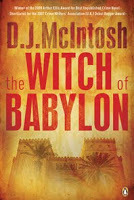
In the early 1980s, I came up with the basic plot for a heroine's journey novel called SARABANDE. Today, I finally sent the manuscript to my publisher.
I avoided writing the novel for almost 30 years because it took me that long to feel confident enough to write a novel told from the viewpoint of a female protagonist. Heroine's journeys, also called lunar journeys, are dark. SARABANDE has some dark scenes that were painful for me to write.
As I finished up my editing and rewriting--much of which focused on those scenes in chapters three and seven-- The Witch of Babylon arrived on my doorstep from Penguin. Written by D. J. McIntosh, the book is billed as the first in the "Mesopotamian Trilogy."
Those of you who have enjoyed the "ancient secrets" books by Dan Brown, Katherine Neville, and Raymond Khoury will love this book. I am enjoying the book because it's (as they say) a page-turner. It's also what I needed while editing SARABANDE.
Why? Because it diverted my attention from those painful scenes. I really did need to come up for air, take a break, smell the roses and zone out. "The Witch of Babylon" was the strong and addictive medicine I needed.
This morning, with the witch's help, SARABANDE is now sitting at Vanilla Heart Publishing waiting for my trusty editor to go through it and my wonderful publisher to turn it into a book.
Meanwhile, I'm enjoying the closing chapters of "The Witch of Babylon."
--Malcolm

Published on July 21, 2011 09:28
July 14, 2011
Becoming uplugged from the rat race is so hard to do
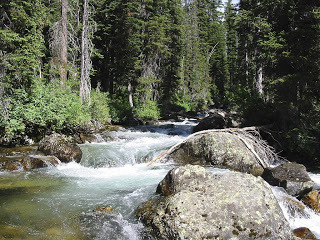
There are days when the "Zen" and the "Create Your Own Reality" of my fiction seems a lot more like fiction than I normally believe. If one can remain relaxed and placid and depend on the magic of apparent coincidences, then s/he will be in the flow without having to twist, turn and fret about making positive serendipity happen. My peaceful life would be spent in a mountain cabin alongside a peaceful mountain stream.
All it takes (apparently) is a computer problem to prove just how much the PC I would like to ignore has become an indispensable part of my daily life. Since I don't know who else to blame for this problem, I'm blaming whoever came up with the idea that writers need to do their own promotion.
In the old days--as I nostalgically fictionalize this problem--a writer sent his/her stuff to an agent. The agent sent it to the publisher. The publisher sold millions of copies. The author got royalty checks while keeping the beer cold in the bubbling, glacier-fed creek behind the house.
We can't do that any more because, as the new gurus tell us, we need to spend 100 hours promoting our work online for every hour we spend actually writing and editing. Enter, the evil computer with the hundreds of little connections to blogs, authors' bulletin boards and chat rooms, marketing gurus, social networking places, and a thousand other rat race highways where one has to maintain a presence to sell any books.
My primary computer, a two-year-old Dell Inspiron 330, has been down for two days. It won't boot. The hard drive is bad, corrupted, missing...nobody knows. It will probably be cheaper to replace it than to fix it. Meanwhile, the disruption is worse than the problem itself.
With the computer, I'm stuck in the very rat race my friend Nancy Reiter described in her book Unplugged: How to Disconnect from the Rat Race, Have an Existential Crisis, and Find Meaning and Fulfillment. Without the computer, I'm out of the rat race and out of touch.
I don't have an answer to this. It's just that as a preacher of an unplugged lifestyle, I feel like I'm an Elmer Gantry con man. Perhaps my books should come with a disclaimer: "Don't do as I do. Do as my characters do."
I like the idea of moving away and finding that mountain stream, but so far the biggest drawback is going to be that the stream doesn't have WiFi.
--Malcolm
Published on July 14, 2011 12:11
July 7, 2011
House Funding Bill Reverses Policy to Protect Grand Canyon
from the National Parks and Conservation Association:
Rider on Interior Appropriations Would Severely Degrade National Park, Reduce Overall National Park Funding
July 7, 2011 Statement by NPCA Senior Vice President of Government Affairs Craig Obey

"Today, the House Interior Appropriations Subcommittee unveiled legislation that is a direct assault on the preservation of Grand Canyon National Park and the Colorado River. The bill includes a rider to prevent a much-needed temporary moratorium that protects Grand Canyon National Park and the Colorado River from contamination by uranium mining.
"The moratorium recently announced by Interior Secretary Salazar protects one million acres of federal lands around the Grand Canyon from uranium mining. This decision ensures future generations will be able to enjoy a Grand Canyon unmarred from this development, and a Colorado River that has a fragile ecology is protected. The House rider would overturn this important decision.
"By keeping this beloved national park unspoiled by inappropriate development, the moratorium allows the Grand Canyon to continue to be a major economic engine for Arizona and across the region, estimated in a Northern Arizona University study as being responsible for bringing $687 million in revenue to the region and creating more than 12,000 full-time jobs. And, in addition to securing the Grand Canyon's natural beauty and its place as an economic jewel, this moratorium will also prevent further infiltration of dangerous contaminants, including uranium itself, into the Colorado River, which supplies drinking water to 25 million people.
"Proposed funding under the bill is also worrisome. The overall funding level in the Interior appropriations bill is fundamentally insufficient to meet many basic conservation needs. In relative terms, the Interior bill cuts National Park Service operations funding far less than many other programs, and it is clear the subcommittee did its best to protect this fundamentally important area. Nonetheless, the $18 million in operational cuts would mark the second consecutive year of reductions in the NPS operating account—unprecedented in post-World War II history—beginning a slow but steady return to the crisis days the parks experienced only a few short years ago.
"That cut, together with the virtual eradication of the Land and Water Conservation fund and an appropriation for construction more than 30 percent below the level the Park Service received in FY 2010means that overall funding for National Park Service programs would be, in real terms, $480 million below FY 2002.
"For all of these reasons, National Parks Conservation Association must oppose this bill."
-
As a long-time member of the National Parks and Conservation Association, I see many articles and news releases about threats to the environment. One of the greatest insults, I think, is when they come from the very people who are supposed to be working on our behalf to protect wild places.
--Malcolm
Rider on Interior Appropriations Would Severely Degrade National Park, Reduce Overall National Park Funding
July 7, 2011 Statement by NPCA Senior Vice President of Government Affairs Craig Obey

"Today, the House Interior Appropriations Subcommittee unveiled legislation that is a direct assault on the preservation of Grand Canyon National Park and the Colorado River. The bill includes a rider to prevent a much-needed temporary moratorium that protects Grand Canyon National Park and the Colorado River from contamination by uranium mining.
"The moratorium recently announced by Interior Secretary Salazar protects one million acres of federal lands around the Grand Canyon from uranium mining. This decision ensures future generations will be able to enjoy a Grand Canyon unmarred from this development, and a Colorado River that has a fragile ecology is protected. The House rider would overturn this important decision.
"By keeping this beloved national park unspoiled by inappropriate development, the moratorium allows the Grand Canyon to continue to be a major economic engine for Arizona and across the region, estimated in a Northern Arizona University study as being responsible for bringing $687 million in revenue to the region and creating more than 12,000 full-time jobs. And, in addition to securing the Grand Canyon's natural beauty and its place as an economic jewel, this moratorium will also prevent further infiltration of dangerous contaminants, including uranium itself, into the Colorado River, which supplies drinking water to 25 million people.
"Proposed funding under the bill is also worrisome. The overall funding level in the Interior appropriations bill is fundamentally insufficient to meet many basic conservation needs. In relative terms, the Interior bill cuts National Park Service operations funding far less than many other programs, and it is clear the subcommittee did its best to protect this fundamentally important area. Nonetheless, the $18 million in operational cuts would mark the second consecutive year of reductions in the NPS operating account—unprecedented in post-World War II history—beginning a slow but steady return to the crisis days the parks experienced only a few short years ago.
"That cut, together with the virtual eradication of the Land and Water Conservation fund and an appropriation for construction more than 30 percent below the level the Park Service received in FY 2010means that overall funding for National Park Service programs would be, in real terms, $480 million below FY 2002.
"For all of these reasons, National Parks Conservation Association must oppose this bill."
-
As a long-time member of the National Parks and Conservation Association, I see many articles and news releases about threats to the environment. One of the greatest insults, I think, is when they come from the very people who are supposed to be working on our behalf to protect wild places.
--Malcolm
Published on July 07, 2011 07:17
July 2, 2011
Sarabande to be Released This Fall
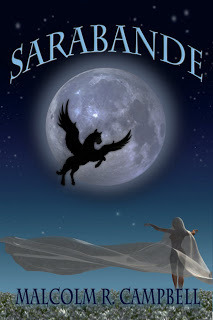
I'm happy to announce that "Sarabande" will be released by Vanilla Heart Publishing in the Fall of 2011.
After Dryad haunts her from beyond the grave for three years, Sarabande undertakes a dangerous journey into the past to either raise her cruel sister from the dead, ending the torment, or to take her place in the safe darkness of the earth.
Sarabande leaves the mountains of Montana for the cornfields of Illinois on a black horse to seek help from Robert Adams, the once powerful Sun Singer, in spite of Gem's prophecy of shame. Siobhan tries to help her with the gift of an enchanted Rowan staff, Danny tries to kill her alongside a deserted prairie road, Billy tries to save her with ancient wisdom, and Robert tries to send her away.
Even if Sarabande persuades Robert to bring the remnants of his magic to Dryad's shallow grave, the desperate man who follows desires the staff for ill intent and the malicious sister who awaits desires much more than a mere return to life.
--Malcolm
Published on July 02, 2011 14:02



